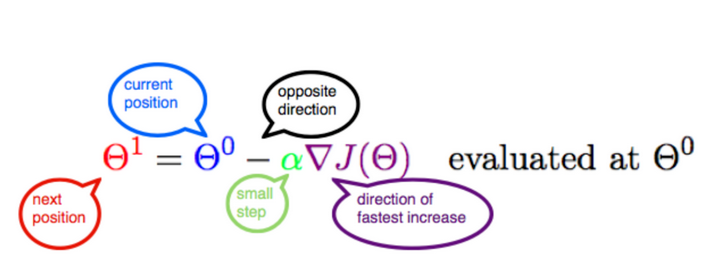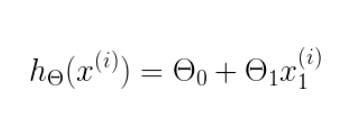flink 批量梯度下降算法线性回归参数求解(Linear Regression with BGD(batch gradient descent) )
1、线性回归
假设线性函数如下:

假设我们有10个样本x1,y1),(x2,y2).....(x10,y10),求解目标就是根据多个样本求解theta0和theta1的最优值。
什么样的θ最好的呢?最能反映这些样本数据之间的规律呢?
为了解决这个问题,我们需要引入误差分析预测值与真实值之间的误差为最小。
2、梯度下降算法
梯度下降的场景:
梯度下降法的基本思想可以类比为一个下山的过程。假设这样一个场景:一个人被困在山上,需要从山上下来(i.e. 找到山的最低点,也就是山谷)。
但此时山上的浓雾很大,导致可视度很低。因此,下山的路径就无法确定,他必须利用自己周围的信息去找到下山的路径。这个时候,他就可以利用梯度下降算法来帮助自己下山。
具体来说就是,以他当前的所处的位置为基准,寻找这个位置最陡峭的地方,然后朝着山的高度下降的地方走,同理,如果我们的目标是上山,也就是爬到山顶,那么此时应该是朝着最陡峭的方向往上走。
然后每走一段距离,都反复采用同一个方法,最后就能成功的抵达山谷。
梯度下降实现:原理baidu,这里略过。下图来自internet,解释的非常到位。

α含义
α在梯度下降算法中被称作为学习率或者步长,意味着我们可以通过α来控制每一步走的距离,以保证不要步子跨的太大,就是不要走太快,错过了最低点。
同时也要保证不要走的太慢,导致太阳下山了,还没有走到山下。所以α的选择在梯度下降法中往往是很重要的!α不能太大也不能太小,太小的话,可能导致迟迟走不到最低点,太大的话,会导致错过最低点! 梯度要乘以一个负号
梯度前加一个负号,就意味着朝着梯度相反的方向前进!梯度的方向实际就是函数在此点上升最快的方向!而我们需要朝着下降最快的方向走,自然就是负的梯度的方向,所以此处需要加上负号。
实现梯度下降,需要定义一个代价函数,比如:

这是均方误差代价函数
m是数据集中点的个数
二分之一(½)是一个常量,这样是为了在求梯度的时候,二次方乘下来就和这里的½抵消了,自然就没有多余的常数系数,方便后续的计算,同时对结果不会有影响
y 是数据集中每个点的真实y坐标的值 h 是预测函数,根据每一个输入x,根据Θ 计算得到预测的y值
即:
3、最终求解公式,代价函数是j=h(x)-y

4、代码实现
/**
* @Author: xu.dm
* @Date: 2019/7/16 21:52
* @Description: 批量梯度下降算法解决线性回归 y = theta0 + theta1*x 的参数求解。
* 本例实现一元数据求解二元参数。
* BGD(批量梯度下降)算法的线性回归是一种迭代聚类算法,其工作原理如下:
* BGD给出了数据集和目标集,试图找出适合目标集的数据集的最佳参数。
* 在每次迭代中,算法计算代价函数(cost function)的梯度并使用它来更新所有参数。
* 算法在固定次数的迭代后终止(如本实现中所示)通过足够的迭代,算法可以最小化成本函数并找到最佳参数。
* Linear Regression with BGD(batch gradient descent) algorithm is an iterative clustering algorithm and works as follows:
* Giving a data set and target set, the BGD try to find out the best parameters for the data set to fit the target set.
* In each iteration, the algorithm computes the gradient of the cost function and use it to update all the parameters.
* The algorithm terminates after a fixed number of iterations (as in this implementation)
* With enough iteration, the algorithm can minimize the cost function and find the best parameters
*
* This implementation works on one-dimensional data. And find the two-dimensional theta.
* It find the best Theta parameter to fit the target.
*
* <p>Input files are plain text files and must be formatted as follows:
* <ul>
* <li>Data points are represented as two double values separated by a blank character. The first one represent the X(the training data) and the second represent the Y(target).
* Data points are separated by newline characters.<br>
* For example <code>"-0.02 -0.04\n5.3 10.6\n"</code> gives two data points (x=-0.02, y=-0.04) and (x=5.3, y=10.6).
* </ul>
*/
public class LinearRegression {
public static void main(String args[]) throws Exception{
final ParameterTool params = ParameterTool.fromArgs(args); final ExecutionEnvironment env = ExecutionEnvironment.getExecutionEnvironment(); env.getConfig().setGlobalJobParameters(params); final int iterations = params.getInt("iterations", 10); // get input x data from elements
DataSet<Data> data;
if (params.has("input")) {
// read data from CSV file
data = env.readCsvFile(params.get("input"))
.fieldDelimiter(" ")
.includeFields(true, true)
.pojoType(Data.class);
} else {
System.out.println("Executing LinearRegression example with default input data set.");
System.out.println("Use --input to specify file input.");
data = LinearRegressionData.getDefaultDataDataSet(env);
} // get the parameters from elements
DataSet<Params> parameters = LinearRegressionData.getDefaultParamsDataSet(env); // set number of bulk iterations for SGD linear Regression
IterativeDataSet<Params> loop = parameters.iterate(iterations); DataSet<Params> newParameters = data
// compute a single step using every sample
.map(new SubUpdate()).withBroadcastSet(loop,"parameters")
// sum up all the steps
.reduce(new UpdateAccumulator())
// average the steps and update all parameters
.map(new Update()); // feed new parameters back into next iteration
DataSet<Params> result = loop.closeWith(newParameters); // emit result
if (params.has("output")) {
result.writeAsText(params.get("output"));
// execute program
env.execute("Linear Regression example");
} else {
System.out.println("Printing result to stdout. Use --output to specify output path.");
result.print();
} } /**
* A simple data sample, x means the input, and y means the target.
*/
public static class Data implements Serializable{
public double x, y; public Data() {} public Data(double x, double y) {
this.x = x;
this.y = y;
} @Override
public String toString() {
return "(" + x + "|" + y + ")";
} } /**
* A set of parameters -- theta0, theta1.
*/
public static class Params implements Serializable { private double theta0, theta1; public Params() {} public Params(double x0, double x1) {
this.theta0 = x0;
this.theta1 = x1;
} @Override
public String toString() {
return theta0 + " " + theta1;
} public double getTheta0() {
return theta0;
} public double getTheta1() {
return theta1;
} public void setTheta0(double theta0) {
this.theta0 = theta0;
} public void setTheta1(double theta1) {
this.theta1 = theta1;
} public Params div(Integer a) {
this.theta0 = theta0 / a;
this.theta1 = theta1 / a;
return this;
} } /**
* Compute a single BGD type update for every parameters.
* h(x) = theta0*X0 + theta1*X1,假设X0=1,则h(x) = theta0 + theta1*X1,即y = theta0 + theta1*x
* 代价函数:j=h(x)-y,这里用的是比较简单的cost function
* theta0 = theta0 - α∑(h(x)-y)
* theta1 = theta1 - α∑((h(x)-y)*x)
*
*/
public static class SubUpdate extends RichMapFunction<Data, Tuple2<Params, Integer>> { private Collection<Params> parameters; private Params parameter; private int count = 1; /** Reads the parameters from a broadcast variable into a collection. */
@Override
public void open(Configuration parameters) throws Exception {
this.parameters = getRuntimeContext().getBroadcastVariable("parameters");
} @Override
public Tuple2<Params, Integer> map(Data in) throws Exception { for (Params p : parameters){
this.parameter = p;
}
//核心计算,对于y = theta0 + theta1*x 假定theta0乘以X0=1,所以theta0计算不用乘以in.x
double theta0 = parameter.theta0 - 0.01 * ((parameter.theta0 + (parameter.theta1 * in.x)) - in.y);
double theta1 = parameter.theta1 - 0.01 * (((parameter.theta0 + (parameter.theta1 * in.x)) - in.y) * in.x);
System.out.println("theta0: "+theta0+" , theta1: "+theta1); return new Tuple2<>(new Params(theta0, theta1), count);
}
} /**
* Accumulator all the update.
* */
public static class UpdateAccumulator implements ReduceFunction<Tuple2<Params, Integer>> { @Override
public Tuple2<Params, Integer> reduce(Tuple2<Params, Integer> val1, Tuple2<Params, Integer> val2) { double newTheta0 = val1.f0.theta0 + val2.f0.theta0;
double newTheta1 = val1.f0.theta1 + val2.f0.theta1;
Params result = new Params(newTheta0, newTheta1);
return new Tuple2<>(result, val1.f1 + val2.f1); }
} /**
* Compute the final update by average them.
*/
public static class Update implements MapFunction<Tuple2<Params, Integer>, Params> { @Override
public Params map(Tuple2<Params, Integer> arg0) throws Exception { return arg0.f0.div(arg0.f1); } }
}
数据准备:
public class LinearRegressionData {
// We have the data as object arrays so that we can also generate Scala Data
// Sources from it.
public static final Object[][] PARAMS = new Object[][] { new Object[] {
0.0, 0.0 } };
public static final Object[][] DATA = new Object[][] {
new Object[] { 0.5, 1.0 }, new Object[] { 1.0, 2.0 },
new Object[] { 2.0, 4.0 }, new Object[] { 3.0, 6.0 },
new Object[] { 4.0, 8.0 }, new Object[] { 5.0, 10.0 },
new Object[] { 6.0, 12.0 }, new Object[] { 7.0, 14.0 },
new Object[] { 8.0, 16.0 }, new Object[] { 9.0, 18.0 },
new Object[] { 10.0, 20.0 }, new Object[] { -0.08, -0.16 },
new Object[] { 0.13, 0.26 }, new Object[] { -1.17, -2.35 },
new Object[] { 1.72, 3.45 }, new Object[] { 1.70, 3.41 },
new Object[] { 1.20, 2.41 }, new Object[] { -0.59, -1.18 },
new Object[] { 0.28, 0.57 }, new Object[] { 1.65, 3.30 },
new Object[] { -0.55, -1.08 } };
public static DataSet<LinearRegression.Params> getDefaultParamsDataSet(ExecutionEnvironment env) {
List<LinearRegression.Params> paramsList = new LinkedList<>();
for (Object[] params : PARAMS) {
paramsList.add(new LinearRegression.Params((Double) params[0], (Double) params[1]));
}
return env.fromCollection(paramsList);
}
public static DataSet<LinearRegression.Data> getDefaultDataDataSet(ExecutionEnvironment env) {
List<LinearRegression.Data> dataList = new LinkedList<>();
for (Object[] data : DATA) {
dataList.add(new LinearRegression.Data((Double) data[0], (Double) data[1]));
}
return env.fromCollection(dataList);
}
}
flink 批量梯度下降算法线性回归参数求解(Linear Regression with BGD(batch gradient descent) )的更多相关文章
- ng机器学习视频笔记(二) ——梯度下降算法解释以及求解θ
ng机器学习视频笔记(二) --梯度下降算法解释以及求解θ (转载请附上本文链接--linhxx) 一.解释梯度算法 梯度算法公式以及简化的代价函数图,如上图所示. 1)偏导数 由上图可知,在a点 ...
- 线性回归模型(Linear Regression)及Python实现
线性回归模型(Linear Regression)及Python实现 http://www.cnblogs.com/sumai 1.模型 对于一份数据,它有两个变量,分别是Petal.Width和Se ...
- 贝叶斯线性回归(Bayesian Linear Regression)
贝叶斯线性回归(Bayesian Linear Regression) 2016年06月21日 09:50:40 Duanxx 阅读数 54254更多 分类专栏: 监督学习 版权声明:本文为博主原 ...
- 局部权重线性回归(Locally weighted linear regression)
在线性回归中,因为对參数个数选择的问题是在问题求解之前已经确定好的,因此參数的个数不能非常好的确定,假设參数个数过少可能拟合度不好,产生欠拟合(underfitting)问题,或者參数过多,使得函数过 ...
- 几种梯度下降方法对比(Batch gradient descent、Mini-batch gradient descent 和 stochastic gradient descent)
https://blog.csdn.net/u012328159/article/details/80252012 我们在训练神经网络模型时,最常用的就是梯度下降,这篇博客主要介绍下几种梯度下降的变种 ...
- 梯度下降算法&线性回归算法
**机器学习的过程说白了就是让我们编写一个函数使得costfunction最小,并且此时的参数值就是最佳参数值. 定义 假设存在一个代价函数 fun:\(J\left(\theta_{0}, \the ...
- 随机梯度下降(Stochastic gradient descent)和 批量梯度下降(Batch gradient descent )的公式对比、实现对比[转]
梯度下降(GD)是最小化风险函数.损失函数的一种常用方法,随机梯度下降和批量梯度下降是两种迭代求解思路,下面从公式和实现的角度对两者进行分析,如有哪个方面写的不对,希望网友纠正. 下面的h(x)是要拟 ...
- 【转】 随机梯度下降(Stochastic gradient descent)和 批量梯度下降(Batch gradient descent )的公式对比、实现对比
梯度下降(GD)是最小化风险函数.损失函数的一种常用方法,随机梯度下降和批量梯度下降是两种迭代求解思路,下面从公式和实现的角度对两者进行分析,如有哪个方面写的不对,希望网友纠正. 下面的h(x)是要拟 ...
- 机器学习-随机梯度下降(Stochastic gradient descent)和 批量梯度下降(Batch gradient descent )
梯度下降(GD)是最小化风险函数.损失函数的一种常用方法,随机梯度下降和批量梯度下降是两种迭代求解思路,下面从公式和实现的角度对两者进行分析,如有哪个方面写的不对,希望网友纠正. 下面的h(x)是要拟 ...
随机推荐
- Oracle第二话之调优工具
Oracle第二话之调优工具 原创if 0 = -I can 发布于2019-04-09 19:53:12 阅读数 172 收藏 展开 目录 1.告警日志 2.用户进程trace文件 3.动态性能视 ...
- Django—常见问题解决
让Django项目运行允许外部访问 1.将python manage.py runserver 改为 python manage.py runserver 0.0.0.0:80 或者 python m ...
- .htaccess设置301跳转及常用技巧整理
在虚拟主机环境中,基本上都是Apache环境.Apache的伪静态的设置,都是在网站根目录设置.htaccess文件,在.htaccess文件中无论是伪静态, 还是301跳转,甚至是防盗链和禁止某个I ...
- Ubuntu18.04 安装TensorFlow 和 Keras
TensorFlow和Keras是当前两款主流的深度学习框架,Keras被采纳为TensorFlow的高级API,平时做深度学习任务,可以使用Keras作为深度学习框架,并用TensorFlow作为后 ...
- 3. Vue - 指令系统
一.vue指令 (1) v-if // 条件判断 如果条件成立就在页面上生成一个标签并显示出来 (2) v-show //DOM中都存在只是显示与否 (3) v-for //注意 v-bind:key ...
- keras 学习笔记(二) ——— data_generator
data_generator 每次输出一个batch,基于keras.utils.Sequence Base object for fitting to a sequence of data, suc ...
- 剑指Offer-5.用两个栈实现队列(C++/Java)
题目: 用两个栈来实现一个队列,完成队列的Push和Pop操作. 队列中的元素为int类型. 分析: 栈的特点是先进后出,队列的特点则是先进先出. 题目要求我们用两个栈来实现一个队列,栈和队列都有入栈 ...
- 详解C++ STL multiset 容器
详解C++ STL multiset 容器 本篇随笔简单介绍一下\(C++STL\)中\(multiset\)容器的使用方法及常见使用技巧. multiset容器的概念和性质 \(set\)在英文中的 ...
- Ubuntu16.04下安装Cmake-3.8.2并为其配置环境变量
下载安装包 首先我们到官网下载最新的cmake二进制安装包https://cmake.org/files/ 这里,我下载的是比较新的cmake-3.8.2-Linux-x86_64.tar.gz解压安 ...
- MySQL SQL DLL (数据定义语言)
CREATE CREATE DATABASE CREATE DATABASE 用于创建数据库 CREATE DATABASE new_database_name; CREATE TABLE CREAT ...
